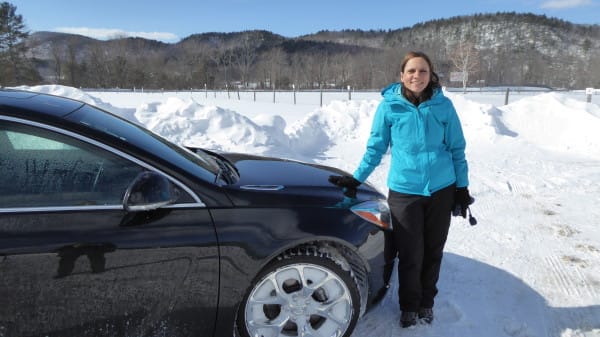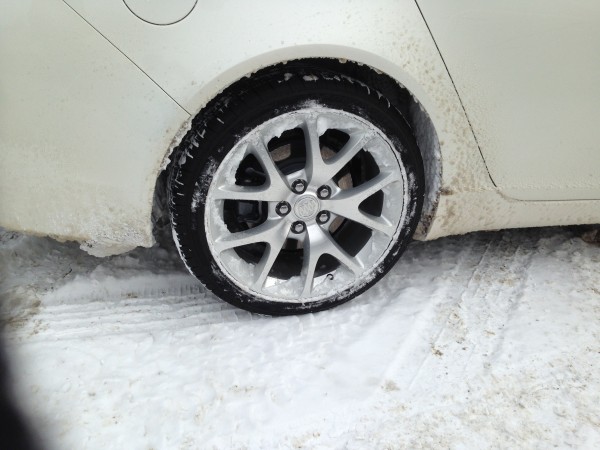Driving On Snow And Ice: How To Have Fun And Not Get Stuck

All Wheel Drive, 4 Wheel Drive, sedans and SUVs: which is best to master bad weather on the road? The answers will surprise you.
I did something last week I never thought I’d do in a million, gazillion years: I had fun in the snow.
A LOT of fun (and I’m not a snow fan). That’s because we were driving all wheel drive Buick Regal sedans, and Encores, the company’s compact SUV. And, we were taken out to a track at Lime Rock Park in the snowy hills of Litchfield County, Connecticut, where other than burying a few orange cones in the snow, we couldn’t get into too much trouble.
The idea was to understand how to drive in the snow and ice, and to appreciate the capability that all wheel drive gives you on the road. And, yes, I learned a lot.
First, I learned that:
- When I’m in my SUV I take for granted the ability to drive in snow
- I (used to) think that sedans are not as capable as SUVs are in the snow, and I (was) wrong
- I think driving in the snow is scary and try to avoid doing it (wrong again)
- Driving on ice and driving on snow aren’t the same thing
- You’ll still go a long way after slamming on your brakes, even with AWD – you just won’t slide
AWD sedans are just as capable – if not more – as SUVs in the snow
Who knew? Turns out it’s all about the wheels feeding back information to the car, and the car in turn feeding instructions to the wheels. This can be done on any type of car, not just large ones with big tires, though the size of car and its tires can help in deep snow.
In fact, if you have all four tires operating independently of each other you have twice as much traction and control as a front wheel drive. (Don’t get me started on rear wheel drive, which is what my car is, and it’s useless in the snow.) That is the definition of AWD:
- All four wheels operating and responding to road conditions independently.
Each wheel can even turn at the speed it needs, such as when one wheel is on a wet or icy surface while the others are on dry pavement, or when you’re making a turn (the inside wheels need to move slower than the outside wheels).
Here is how all wheel drive functions in the snow, and some tricks you can use to drive safely in the snow:
We compared driving the Encore and the Regal; the difference is that the Encore, because it’s higher off the ground, is better able to clear deep snow. It also felt more ‘natural’ in that I didn’t feel the snow and ice as much as I did in the sedan. That’s not necessarily a good thing; being aware of the road’s condition makes you better able to manage it. The Regal was more fun to drive in the snow than the Encore; I could feel the wheels in the snow and was therefore better able to control the path of the car.
Next, I learned that AWD isn’t the same as 4 wheel drive
The two are often confused but aren’t interchangeable. 4WD is more common on big trucks, SUVs and vehicles built to go off road. The definition of 4WD:
- Wheel function is locked together and delivers equal power to each axle to propel you over rocks, mud or snow.
Many 4WD vehicles are rear wheel drive except when 4WD is engaged, such as when you push the gear selector into 4WD. This is nice because powering all four wheels all the time requires extra fuel; using rear wheel drive most of the time will save gas and money.
OK, AWD will get me where I’m going. What else is there to know?
It turns out, even with the power of AWD (or 4WD), you still have to know how to handle your car in the snow or ice. That’s where the fun comes in.
Out on the track, which was really a field of snow with some orange cones outlining the course, we did three things:
- We slammed on the brakes to see just how long it takes to stop
- We slid through the curves to see how to recover steering when snow or ice makes the car slip
- We turned off the traction control to see how the car would react without it; the car slid around a lot more, making me realize what a lazy driver I am–I’m used to the car doing everything for me!
Braking in the snow
I was shocked—shocked!— to find that when I slammed on my brakes, the car still slid a good 100 or so feet along the course. I could feel the brakes shudder under my foot as I pressed the brake pedal to the floor, and it’s worth noting that no matter how hard I pressed, the car didn’t stop any quicker. That’s the magic of ABS brakes, which will stop you quicker than old fashioned brakes that lock up the wheels and let the car slide to a stop. If you’re not driving a car built before about 1995, then you probably have not experienced this.
It’s also worth noting that on the snow, I was going about 30 MPH before hitting the brakes. In a braking test with Continental tires last spring, we noted that stopping distances (from a speed of 50 MPH) on dry pavement was about 75 feet, while on wet pavement we went about 130 feet. I felt that for being in the snow, and compared to the Continental test, the stopping distance was pretty good in the snow, Certainly AWD takes some of the credit.
Shredding snow in the Buick Regal
Next came the FUN part: taking curves and in the snow and ice. At first, though, it was a little scary. When you hit a curve and feel the front end of the car start to slide, you feel so out of control. And of course, your first instinct is to hit the brakes. Wrong. Here’s what you should do when feeling the car slide:
- Let off the gas or brakes—you don’t want to slow your momentum, just shift it
- DO NOT apply the brakes
- Look to the direction you want to go (not where you’re headed)
- Steer to the direction you want to go
- Don’t oversteer; this could send you the opposite direction or even spin the car around
- Gently apply the GAS to power out of the slide

Lisa Jesme, Driveline Engineer, Buick, and the Regal she commanded around the track at Buick’s winter drive event
As you ease off the gas or give the car gas while in a slide, you are more empowered to control the curve, as opposed to becoming a victim to it. This, paired with looking to the direction you want to go, will get you out of a slide and send you on your way, rather than into a wall or ditch. This also gives AWD the power to command, rather than react, to the road conditions.
On the ice it was a little tricker, but the same rules applied; the Regal’s wheels slipped on the ice but dug into the snow, regaining its traction. Keeping up the power and steering into the turn meant the slip on the ice was a minor bit of thrill before we were back on track.
When and where you can learn to drive on the snow
There are winter driving courses around the country, including one run by Bridgestone Tires. Prices are not crazy; you can get the experience for about $300, probably less than your insurance deductible. Or you can go the old school route: Find an empty parking lot—one you know is clear of parking stops, parking medians, fire hydrants or other obstructions, and go for a quick spin. Test your braking, stopping and feel your way through a snowy curve. You’ll walk away with a greater sense of confidence for when winter weather challenges your skills.

Disclosure: I was Buick’s guest at Lime Rock Park for this winter test drive experience; I was not paid or compensated for this post and opinions expressed are all mine.



